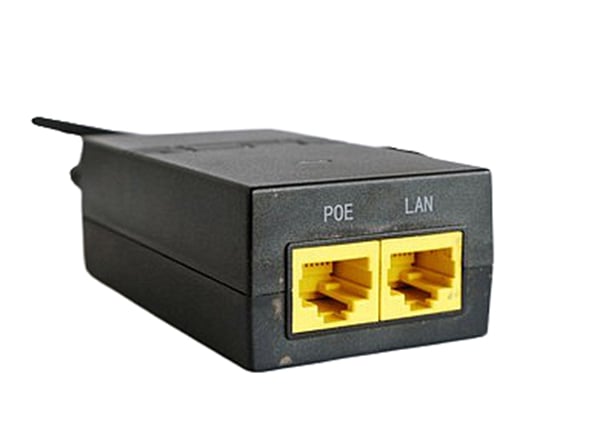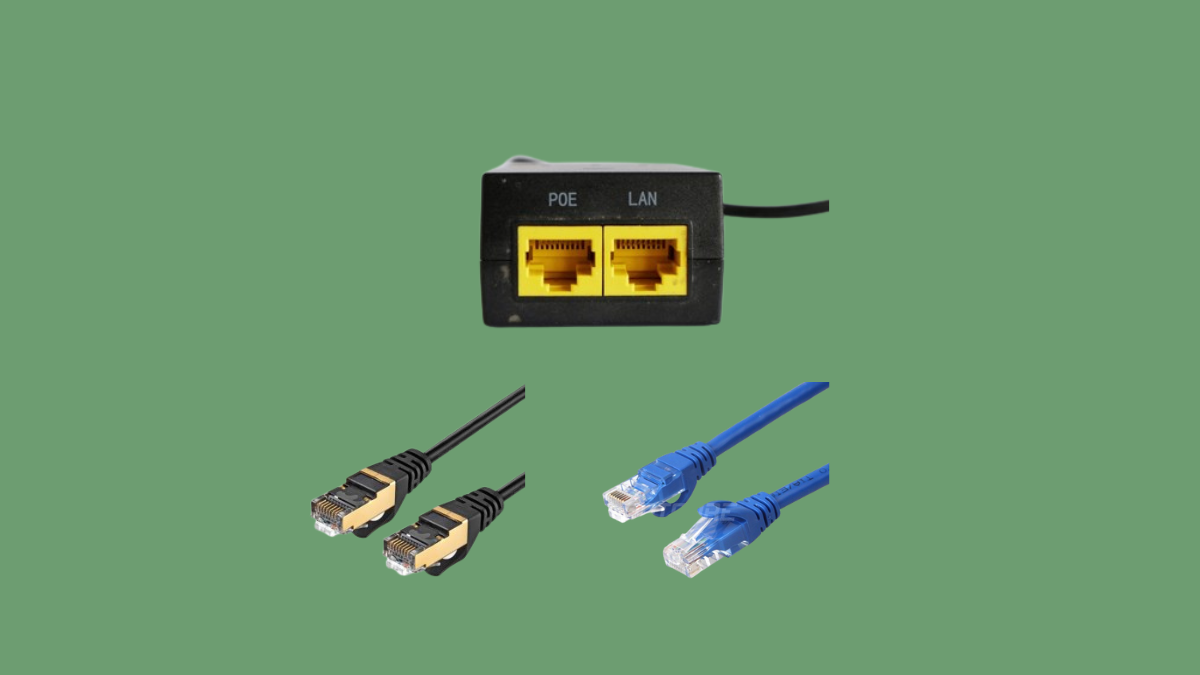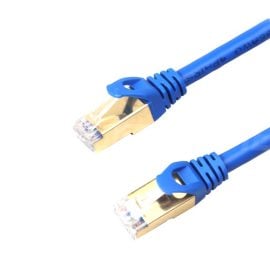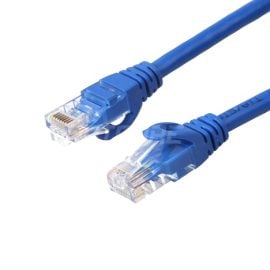Blog, Networking Device
What Is PoE Injector: A Beginner’s Guide
Suppose your network devices do not have non-PoE LAN switch ports. In that case, you’ll need a PoE injector (also known as a PoE adapter or midspan adapter) to connect PoE-enabled equipment. So, what is PoE injector? More simply, it is a device that connects wireless access points (WAPs), network cameras, VoIP phones, or any IEEE 802.3af/at/bt-powered devices (PDs) to network switches. Read this guide to find your injectors and learn how to use them correctly.
Let’s move to its definition and the other two variants.
Table of contents
What Is PoE Injector
A power over Ethernet injector is a device supplying electrical power to network power over Ethernet devices via Ethernet cables. These cables include Cat6, Cat6A, Cat7 and Cat8. Look at our website to get the cables you want.
Recommended products
-
Cat6 Snagless Shielded (SFTP) Ethernet Network Patch Cable, PVC, Blue
Price range: US$ 1.29 through US$ 17.70 (Excl. VAT) -
Cat6 Ethernet Network Patch Cable, Snagless Unshielded (UTP), PVC, Blue
Price range: US$ 0.85 through US$ 13.10 (Excl. VAT) -
Cat7 Snagless Shielded (SFTP) Ethernet Network Patch Cable, PVC, Blue
Price range: US$ 2.20 through US$ 25.80 (Excl. VAT) -
Cat8 Snagless Shielded (SFTP) 25G/40GBase-T Ethernet Network Patch Cable, PVC, Black
Price range: US$ 2.25 through US$ 28.80 (Excl. VAT)
As a standalone device, a midspan adapter complies with IEEE 802.3af/at/bt standards. It relies on Ethernet cables for simultaneous data transmission and power supply to connected PoE-supported devices. Using these injectors, you can make the installation and deployment of network devices simpler.

What Is PoE+ Injector
According to various IEEE 802.3af/at/bt standards, there are PoE+ and PoE++ injectors. But what are these in essence? Let me explain them one by one. A power over Ethernet plus injector adheres to the IEEE 802.3 protocol, providing up to 30 watts per port. However, a PoE adapter supports up to 15.4 watts per port.
What Is PoE++ Injector
They have the same functions as their counterparts. It offers up to 90 watts per port, which is the highest among the three. Also, it is defined by the IEEE 802.3bt standard.
Here’s a table for you to look more closely at these injectors.
| PoE Standard | PoE Injector Name | Power Output | Usage |
| IEEE 802.3af | PoE injector | 15.40 W | 12.95 W power for connected powered devices (PDs) |
| IEEE 802.3at | PoE+ injector | 30 W | 25.50 W power for connected PDs |
| IEEE 802.3bt Type 3 | PoE++ injector | 60 W | 51 W power for connected PDs |
| IEEE 802.3bt Type 4 | Ultra PoE injector | 100 W | 71 W power for connected PDs |
Types of PoE Injectors
To choose suitable PoE injectors, you should first know their different types. Here, in grammar, the phrase “PoE power injector” is incorrect. Many people may search so; it doesn’t make any difference in Google. Here’s a breakdown of its major types.
Single-Port Injectors
They ideally fit the needs of small installations, bringing power over Ethernet functionality to individual devices. They can transmit data and power to connected devices, such as IP cameras, via a single Ethernet cable.
Multi-Port Injectors
For large or complex installations, multi-port injectors, such as eight-port power over Ethernet adapters, take center stage. They provide multiple devices with power and data at the same time. Nowadays, office buildings and industrial facilities use them to connect various PoE-compatible devices, including routers and lighting systems.
Active vs. Passive PoE Injector
When an injector conforms to the PoE standards of IEEE 802.3af, IEEE 802.3at, or IEEE 802.3bt, it is referred to as an active one. By contrast, an injector that does not obey the above three protocols is passive. The power over Ethernet injectors are safer since the use of active injectors powers up when they receive the proper order. Using a passive one, you must connect the right voltage to avoid electrical damage to your devices.
12V vs. 24V vs. 48V PoE Injector
A PoE injector supplies different output power voltages; it comes in three forms: 12V, 24V, and 48V. When selecting a correct midspan adapter, ensure the voltage of your injector is compatible with that of your PoE devices.
Advantages of Using a PoE Injector
Easy Installation
You can install these injectors almost anywhere, especially in areas far from a power outlet. They serve as a simple play-and-plug solution to meeting your PoE needs.
Flexible Network Expansion
The network distances become extended as PoE injectors provide PoE functions for non-PoE switches. Additionally, Ethernet cables make your end device connections possible.
Centralized Power Management
Using a midspan adapter ensures that you distribute power more centrally and manage your network simply. For example, a large company can monitor the power supply to all devices from a single location to enhance work efficiency.
Cost-Effective Solution
A PoE adapter helps you save a bunch since you can avoid the trouble of deploying separate power cables and outlets. Also, the overall cost of installation and maintenance can be reduced. This setup minimizes the clutter of multiple power cables, offering a more organized and efficient working environment.
Energy Efficiency
They help save energy because they only provide the power needed. Your network devices that are not in operation will not receive unnecessary power. In this case, the total energy consumption is relatively low.
How PoE Injectors Work
These setups first link WAPs, IP cameras, PoE lighting, or IEEE 802.3af/at/bt-powered devices to network switches. Electrical Power is then “stored” in an Ethernet cable. In general, a midspan adapter has two RJ45 ports: one is for Data In, and the other is for PoE/Data Out.

Data In port: Take a VoIP phone as an example. The Data In port links your VoIP phone to the local network or a network switch. When the VoIP phone fails to connect to this port, it is impossible to reach the local network.
PoE/Data Out port: Such a port possesses two main functions: enabling power delivery to the VoIP phone and powering the network to ensure successful data transmission. Once this port remains unconnected to your VoIP phone, it will not power up, and network connections will fail.
The completion of the setting process typically needs three devices: a connection to the network, the powered device, and the PoE injector.
How to Choose a PoE Injector
Three key factors help you rightly choose a PoE adapter. They are as follows.
The Number of Powered Devices
If you have only one powered device to be connected, single-port PoE injectors will solve your problem. However, if multiple devices need connecting, you should ensure the injector you buy has enough ports.
PoE Standard
The PoE standard must adhere to your powered devices. IEEE 802.3af (PoE) provides power up to 15.4 watts (W); IEEE 802.3at (PoE+) supplies power up to 30 W; and IEEE 802.3bt (PoE++) offers power up to 100 W.
Power Supply Voltage
The key point to remember is to ensure the voltage of PoE injectors is compliant with the PDs. Otherwise, issues such as overloads or operating errors will arise.
How to Use a PoE Injector
PoE injectors make data transfer more convenient while offering power over Ethernet to standard PoE, PoE+, and PoE++-compliant devices. So, what steps are necessary to use them? Here’s a step-by-step guide for you.
When using a PoE adapter to connect an IP camera, the following items are essential: an IP camera, a PoE adapter, a standard network switch, and Cat6 or Cat6A Ethernet cables.
- Verify the proper functioning of the IP camera, power over Ethernet injector, and camera monitoring system on all devices.
- Create all video and network configurations before your installation.
- Insert one Ethernet cable into the IP camera’s PoE port and the injector’s Power or PoE port.
- Install your IP camera in an area with adequate lighting to capture clear images on the screen.
- Plug another Ethernet cable to connect the injector’s data port to the Ethernet switch.
- Insert the injector power cords into the local AC electrical outlets.
FAQs
#How do you install a PoE injector?
You will need several devices: an IP camera, a PoE adapter, a standard network switch, and Cat5e, Cat6, or Cat6A Ethernet cables.
#Does a PoE injector have manageable ports?
The injector doesn’t have manageable ports. It directly supplies Power to PoE PD through a power source, providing plug-and-play functionality. If you need a management function, consider a PoE switch.
#Is it safe to use a PoE injector? Can it damage my equipment?
IEEE 802.3af/at/bt compliant PoE injectors won’t do damage to any equipment, even though the equipment is not designed for PoE applications.
Conclusion
This guide serves as a roadmap to the question: What Is PoE Injector? It is a device that enables non-PoE compatible switches to work with PoE devices by providing power to PoE-compliant devices over a single Ethernet cable. When choosing the injector you need, refer to our guidelines to understand how to use it properly.
Reference
https://en.wikipedia.org/wiki/Power_over_Ethernet
Read More
- What Is a PoE Camera: A Beginner’s Guide
- What Is PoE Switch: A Complete Guide
- PoE vs PoE+ vs PoE++ vs UPoE vs UPoE+: What is the difference?
- PoE Injector vs. PoE Splitter Comparison










